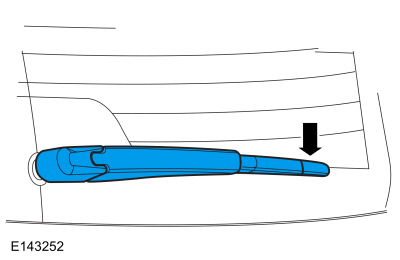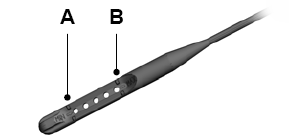Ford Escape: Evaporative Emissions / Description and Operation - Evaporative Emissions - System Operation and Component Description
System Operation
System Diagram

| Item | Description |
|---|---|
| 1 | Intake manifold |
| 2 | EVAP canister purge valve |
| 3 | Fresh air hose |
| 4 | EVAP leak detection pump |
| 5 | EVAP canister |
| 6 | Fuel tank |
| 7 | Fuel pump and sender unit |
| 8 | Fuel tank isolation valve (also known as Tank Pressure Control Valve - TPC ) |
| 9 | Fuel vapor vent valve (also known as Refuelling Valve - RV ) |
| 10 | Fuel tank pressure (FTP) sensor and tube |
| 11 | Fuel tank filler pipe |
Evaporative Emission (EVAP) Systems
The EVAP system prevents fuel vapor build up in the sealed fuel tank. Fuel vapors trapped in the sealed tank are vented through the vapor valve assembly on top of the tank. The vapors leave the valve assembly through a single vapor line and continue to the EVAP canister for storage until the vapors are purged to the engine for burning.
All applications required to meet OBD regulations use the enhanced EVAP system.
Evaporative Emission (EVAP) System
The EVAP system consists of an EVAP leak detection control module, EVAP canister, EVAP purge valve, fuel tank, capless fuel tank filler pipe, fuel vapor vent valve (FVVV), fuel tank isolation valve (FTIV), fuel tank pressure (FTP) sensor, fuel vapor hoses, intake manifold hose assembly, and the PCM .
The fuel tank side is normally sealed by the closed FTIV and the FVVV which block the flow of vapors from the fuel tank to the EVAP canister. This system only allows fuel vapors into the EVAP canister during refueling or an excessive fuel tank pressure condition.
During the EVAP leak check monitor, the PCM controls the EVAP leak detection control module to seal the EVAP canister from the atmospheric pressure by closing the switching valve and applying the target vacuum in the EVAP system by turning ON the vacuum pump. Operation of the system is as follows:
- The FTP sensor monitors the fuel tank pressure and continuously transmits an input signal to the PCM .
- The normally closed FVVV is a PCM controlled valve that blocks the flow of vapors from the fuel tank to the EVAP canister. The PCM opens the FVVV to allow fuel vapors to the EVAP canister during refueling.
- The normally closed FTIV is a PCM controlled valve that blocks the flow of vapors from the fuel tank to the EVAP canister. The FTIV will automatically open to relieve excess pressure or vacuum if the fuel tank pressure or vacuum reaches a maximum calibrated value.
- The EVAP leak detection control module is used to seal the EVAP system from the atmosphere and apply a vacuum on the EVAP system for EVAP leak check monitoring. A vacuum pump inside the EVAP leak detection control module applies a vacuum on EVAP system as needed during the EVAP leak check monitor. The pressure sensor internal to the EVAP leak detection control module monitors the system during the EVAP leak check monitor.
- The EVAP purge valve is used to control the purge flow from the EVAP canister during engine running conditions.
- The EVAP canister is used on the sealed EVAP system to collect fuel vapors during refueling only.
- A valve inside the fuel tank mounted fuel vapor tube assembly prevents liquid fuel from entering the EVAP canister and the EVAP purge valve under any vehicle altitude, handling, or rollover condition.
Component Description
Evaporative Emission (EVAP) Leak Detection Control Module
The EVAP leak detection control module consists of a vacuum pump, a pressure sensor, a 0.02" reference orifice and a switching valve. The vacuum pump is used to apply a vacuum across the reference orifice and to apply a vacuum on the EVAP system for the EVAP leak check monitor. The 0.02" reference orifice is used to obtain a reference check for leak detection every time the EVAP monitor runs. The pressure sensor is used to determine the vacuum level across the reference orifice and for the EVAP leak detection monitor. The EVAP leak detection control module is vented to atmosphere through the switching valve and allows for purging during engine operation and refueling.
Evaporative Emission (EVAP) Purge Valve
The EVAP purge valve (located near the engine) is part of the enhanced EVAP system controlled by the PCM . This valve controls the flow of vapors (purging) from the EVAP canister to the intake manifold during various engine operating modes. The EVAP purge valve is a normally closed valve. The PCM outputs a duty cycle between 0% and 100% to control the EVAP purge valve.
Fuel Tank Isolation Valve (FTIV)
The FTIV is a PCM controlled solenoid that isolates the fuel tank from the rest of the EVAP system. The FTIV is a normally closed valve blocking the flow of vapors from the fuel tank to the EVAP canister. This prevents the canister from becoming saturated causing hydrocarbons (HC) to be released into the atmosphere in a situation where the engine does not run during a drive cycle. The FTIV will automatically open to relieve excess vacuum if the fuel tank vacuum reaches a maximum mechanical relief threshold value.
Fuel Tank Pressure (FTP) Sensor
The in tank FTP sensor or the inline FTP sensor measures the fuel tank pressure.
Fuel Vapor Vent Valve (FVVV)
The FVVV is a PCM controlled solenoid that isolates the fuel tank from the rest of the EVAP system. The PCM opens the FVVV during refueling to allow the flow of vapors from the fuel tank to the EVAP canister. The FVVV will automatically open to relieve excess pressure if the fuel tank pressure reaches a maximum mechanical relief threshold value.
 Description and Operation - Evaporative Emissions - Overview
Description and Operation - Evaporative Emissions - Overview
Overview
The EVAP
system prevents hydrocarbon emissions from entering the atmosphere by
storing fuel vapors and routing the vapors to the engine to be consumed
during normal engine operation...
 Diagnosis and Testing - Evaporative Emissions
Diagnosis and Testing - Evaporative Emissions
Diagnostic Trouble Code (DTC) Chart
Diagnostics in this manual assume a certain skill level and knowledge of Ford-specific diagnostic practices. REFER to: Diagnostic Methods (100-00 General Information, Description and Operation)...
Other information:
Ford Escape 2020-2026 Owners Manual: Under Hood Overview - 2.5L, Hybrid Electric Vehicle (HEV)/Plug-In Hybrid Electric Vehicle (PHEV)
Windshield washer fluid reservoir: See Adding Washer Fluid. Low temp coolant cap: See Checking the Coolant. High temp coolant cap: See Checking the Coolant. Engine oil filler cap: See Adding Engine Oil. Engine oil dipstick: See Engine Oil Dipstick Overview...
Ford Escape 2020-2026 Service Manual: Description and Operation - Turbocharger - System Operation and Component Description
System Operation Turbocharger And Charge Air Cooler (CAC) Systems Turbocharger System A turbocharger is an exhaust gas driven device used to increase the power output of an engine by the turbocharger compressor increasing the pressure of the air entering the engine...
Categories
- Manuals Home
- 4th Generation Ford Escape Owners Manual
- 4th Generation Ford Escape Service Manual
- Adjusting the Headlamps
- Switching the Rear Window Wiper On and Off. Reverse Wipe
- Symbols Glossary
- New on site
- Most important about car
Engine Oil
Engine Oil Dipstick Overview

